MITSUBISHI OUTLANDER SPORT 2014 3.G Owners Manual
Manufacturer: MITSUBISHI, Model Year: 2014, Model line: OUTLANDER SPORT, Model: MITSUBISHI OUTLANDER SPORT 2014 3.GPages: 388, PDF Size: 20.04 MB
Page 191 of 388
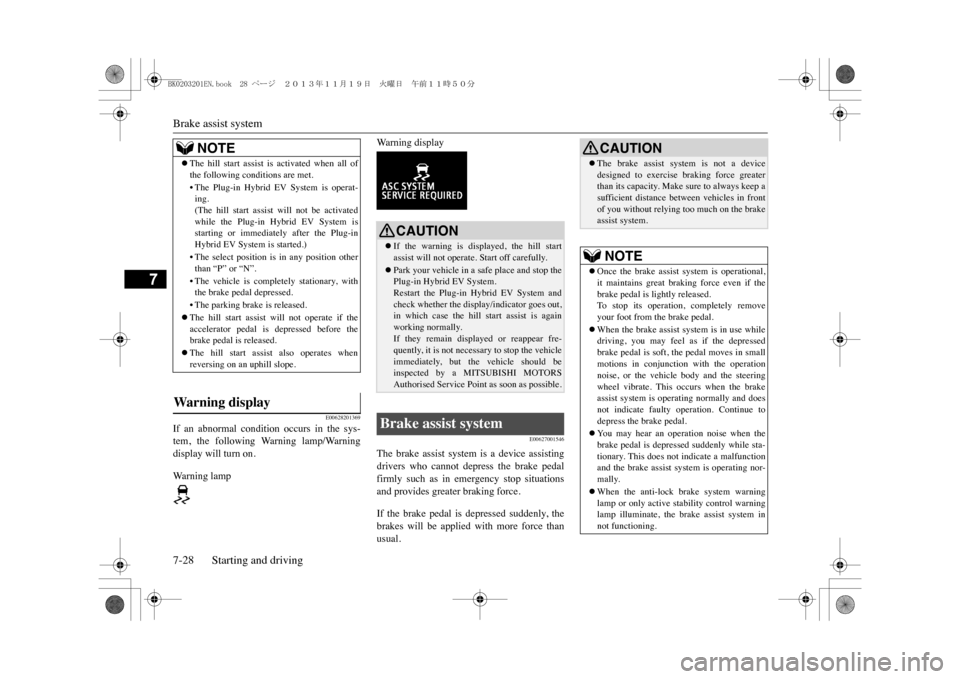
Brake assist system7-28 Starting and driving
7
E00628201369
If an abnormal condition occurs in the sys-tem, the following Warning lamp/Warningdisplay will turn on.Wa r n i n g l a m p
Warning display
E00627001546
The brake assist system
is a device assisting
drivers who cannot depress the brake pedalfirmly such as in emergency stop situationsand provides greater braking force.If the brake pedal is depressed suddenly, thebrakes will be applied with more force thanusual.
NOTE
�zThe hill start assist is activated when all ofthe following conditions are met.•The Plug-in Hybrid EV System is operat-ing.(The hill start assist will not be activatedwhile the Plug-in Hybrid EV System isstarting or immediately after the Plug-inHybrid EV System is started.)• The select position is in any position otherthan “P” or “N”.•The vehicle is completely stationary, withthe brake pedal depressed.• The parking brake is released.�zThe hill start assist will not operate if theaccelerator pedal is depressed before thebrake pedal is released.�zThe hill start assist also operates whenreversing on an uphill slope.
Warn in g di s p lay
CAUTION�zIf the warning is displayed, the hill startassist will not operate. Start off carefully.�zPark your vehicle in a safe place and stop thePlug-in Hybrid EV System.Restart the Plug-in Hybrid EV System andcheck whether the disp
lay/indicator goes out,
in which case the hill start assist is againworking normally.If they remain displayed or reappear fre-quently, it is not necessa
ry to stop the vehicle
immediately, but the vehicle should beinspected by a MITSUBISHI MOTORSAuthorised Service Poin
t as soon as possible.
Brake assist system
CAUTION�zThe brake assist system is not a devicedesigned to exercise braking force greaterthan its capacity. Make sure to always keep asufficient distance be
tween vehicles in front
of you without relying too much on the brakeassist system.NOTE
�zOnce the brake assist system is operational,it maintains great braking force even if thebrake pedal is lightly released.To s t o p i t s o p e r a t i o n , c o m p l e t e l y r e m o v eyour foot from the brake pedal.�zWhen the brake assist system is in use whiledriving, you may feel as if the depressedbrake pedal is soft, the pedal moves in smallmotions in conjunction
with the operation
noise, or the vehicle body and the steeringwheel vibrate. This occurs when the brakeassist system is ope
rating normally and does
not indicate faulty operation. Continue todepress the brake pedal.�zYo u m a y h e a r a n o p e r a t i o n n o i s e w h e n t h ebrake pedal is depressed suddenly while sta-tionary. This does not indicate a malfunctionand the brake assist system is operating nor-mally.�zWhen the anti-lock brake system warninglamp or only active stability control warninglamp illuminate, the brake assist system innot functioning.
BK0203201EN.book 28 ページ 2013年11月19日 火曜日 午前11時50分
Page 192 of 388
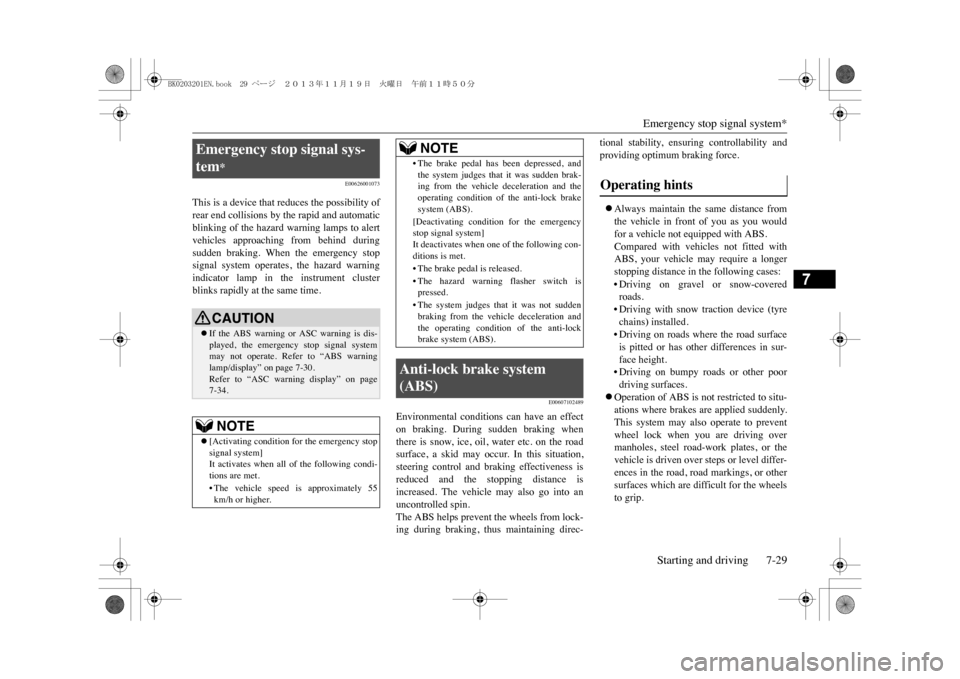
Emergency stop signal system*
Starting and driving 7-29
7
E00626001073
This is a device that reduces the possibility ofrear end collisions by the rapid and automaticblinking of the hazard warning lamps to alertvehicles approaching from behind duringsudden braking. When the emergency stopsignal system operates, the hazard warningindicator lamp in the instrument clusterblinks rapidly at the same time.
E00607102489
Environmental conditions can have an effecton braking. During sudden braking whenthere is snow, ice, oil, water etc. on the roadsurface, a skid may occur. In this situation,steering control and braking effectiveness isreduced and the stopping distance isincreased. The vehicle may also go into anuncontrolled spin.The ABS helps prevent the wheels from lock-ing during braking, thus maintaining direc-
tional stability, ensuring controllability andproviding optimum braking force.�zAlways maintain the same distance fromthe vehicle in front of you as you wouldfor a vehicle not equipped with ABS.Compared with vehicles not fitted withABS, your vehicle may require a longerstopping distance in the following cases:•Driving on gravel or snow-coveredroads.• Driving with snow traction device (tyrechains) installed.•Driving on roads where the road surfaceis pitted or has other differences in sur-face height.• Driving on bumpy roads or other poordriving surfaces.
�zOperation of ABS is not restricted to situ-ations where brakes are applied suddenly.This system may also operate to preventwheel lock when you are driving overmanholes, steel road-work plates, or thevehicle is driven over steps or level differ-ences in the road, road markings, or othersurfaces which are difficult for the wheelsto grip.
Emergency stop signal sys-tem
*CAUTION�zIf the ABS warning or ASC warning is dis-played, the emergency stop signal systemmay not operate. Refer to “ABS warninglamp/display” on page 7-30.Refer to “ASC warn
ing display” on page
7-34.NOTE
�z[Activating condition for the emergency stopsignal system]It activates when all
of the following condi-
tions are met.•The vehicle speed is approximately 55km/h or higher.
•The brake pedal has been depressed, andthe system judges that it was sudden brak-ing from the vehicle deceleration and theoperating condition of the anti-lock brakesystem (ABS).[Deactivating condition for the emergencystop signal system]It deactivates when one of the following con-ditions is met.•The brake pedal is released.• The hazard warning flasher switch ispressed.•The system judges that it was not suddenbraking from the vehicle deceleration andthe operating condition of the anti-lockbrake system (ABS).
Anti-lock brake system (ABS)
NOTE
Operating hints
BK0203201EN.book 29 ページ 2013年11月19日 火曜日 午前11時50分
Page 193 of 388
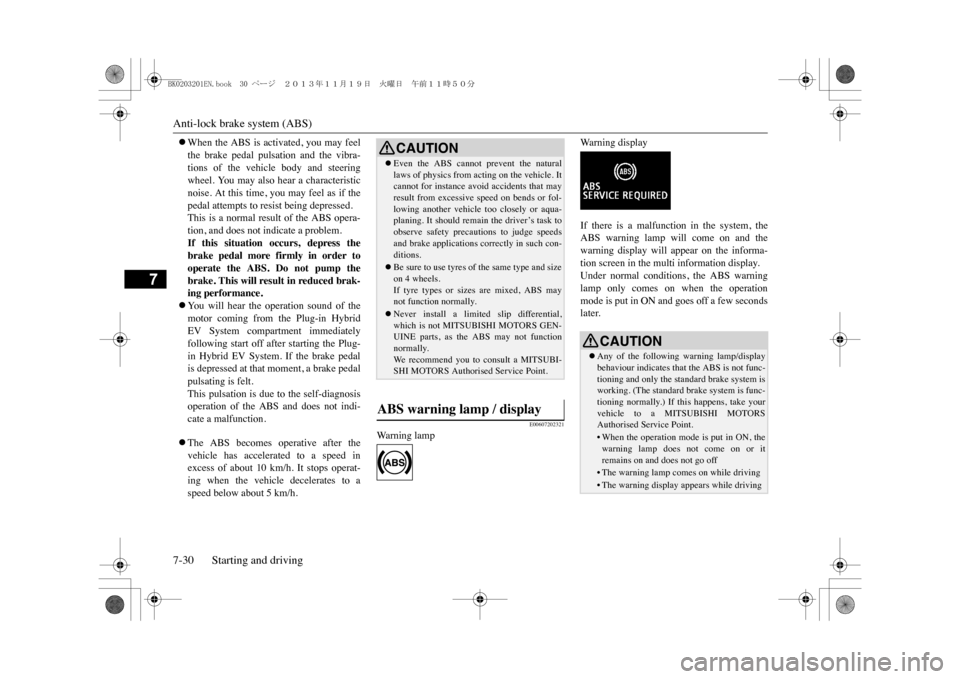
Anti-lock brake system (ABS)7-30 Starting and driving
7
�zWhen the ABS is activated, you may feelthe brake pedal pulsation and the vibra-tions of the vehicle body and steeringwheel. You may also hear a characteristicnoise. At this time, you may feel as if thepedal attempts to resist being depressed.This is a normal result of the ABS opera-tion, and does not indicate a problem.If this situation occurs, depress thebrake pedal more firmly in order tooperate the ABS. Do not pump thebrake. This will result in reduced brak-ing performance.�zYo u w i l l h e a r t h e o p e r a t i o n s o u n d o f t h emotor coming from the Plug-in HybridEV System compartment immediatelyfollowing start off after starting the Plug-in Hybrid EV System. If the brake pedalis depressed at that moment, a brake pedalpulsating is felt.This pulsation is due to the self-diagnosisoperation of the ABS and does not indi-cate a malfunction.�zThe ABS becomes operative after thevehicle has accelerated to a speed inexcess of about 10 km/h. It stops operat-ing when the vehicle decelerates to aspeed below about 5 km/h.
E00607202321
Wa r n i n g l a m p
Wa r n i n g d i s p l a yIf there is a malfunction in the system, theABS warning lamp will come on and thewarning display will appear on the informa-tion screen in the multi information display.Under normal conditions, the ABS warninglamp only comes on when the operationmode is put in ON and goes off a few secondslater.
CAUTION�zEven the ABS cannot prevent the naturallaws of physics from acting on the vehicle. Itcannot for instance avoi
d accidents that may
result from excessive speed on bends or fol-lowing another vehicle
too closely or aqua-
planing. It should remain the driver’s task toobserve safety precau
tions to judge speeds
and brake applications correctly in such con-ditions.�zBe sure to use tyres of the same type and sizeon 4 wheels.If tyre types or sizes are mixed, ABS maynot function normally.�zNever install a limited slip differential,which is not MITSUBISHI MOTORS GEN-UINE parts, as the
ABS may not function
normally.We recommend you to consult a MITSUBI-SHI MOTORS Authorised Service Point.
ABS warning lamp / display
CAUTION�zAny of the following warning lamp/displaybehaviour indicates that
the ABS is not func-
tioning and only the standard brake system isworking. (The standard
brake system is func-
tioning normally.) If this happens, take yourvehicle to a MITSUBISHI MOTORSAuthorised Service Point.•When the operation mode is put in ON, thewarning lamp does not come on or itremains on and does not go off•The warning lamp comes on while driving•The warning display
appears while driving
BK0203201EN.book 30 ページ 2013年11月19日 火曜日 午前11時50分
Page 194 of 388
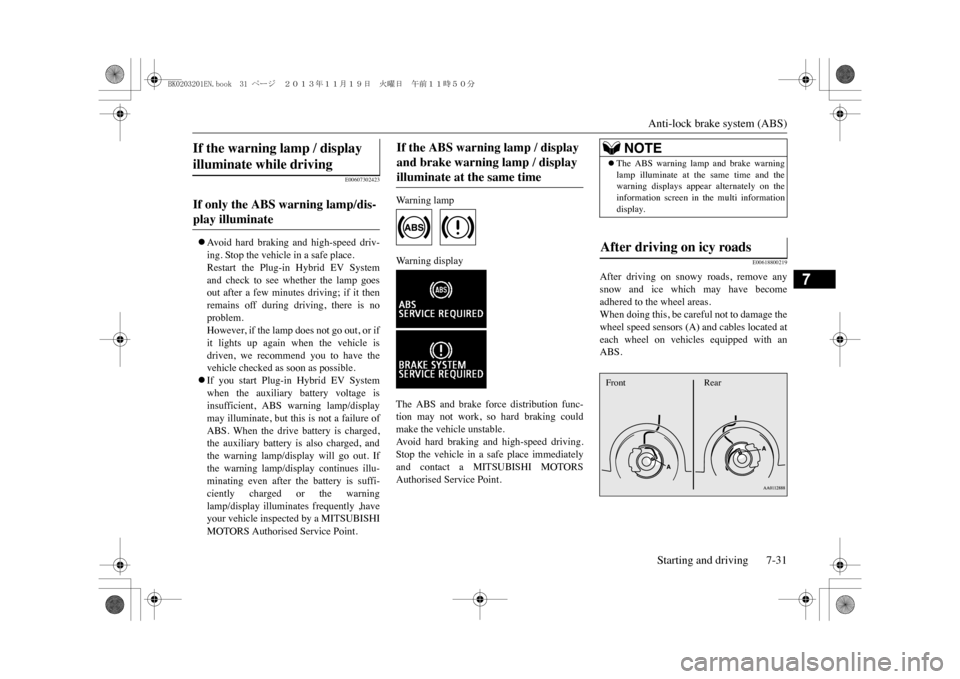
Anti-lock brake system (ABS)Starting and driving 7-31
7
E00607302423
�zAv o i d h a r d b r a k i n g a n d h i g h - s p e e d d r i v -ing. Stop the vehicle in a safe place.Restart the Plug-in Hybrid EV Systemand check to see whether the lamp goesout after a few minutes driving; if it thenremains off during driving, there is noproblem.However, if the lamp does not go out, or ifit lights up again when the vehicle isdriven, we recommend you to have thevehicle checked as soon as possible.�zIf you start Plug-in Hybrid EV Systemwhen the auxiliary battery voltage isinsufficient, ABS warning lamp/displaymay illuminate, but this is not a failure ofABS. When the drive battery is charged,the auxiliary battery is also charged, andthe warning lamp/display will go out. Ifthe warning lamp/display continues illu-minating even after the battery is suffi-ciently charged or the warninglamp/display illuminates frequently ,haveyour vehicle inspected by a MITSUBISHIMOTORS Authorised Service Point.
Wa r n i n g l a m p
Warning displayThe ABS and brake force distribution func-tion may not work, so hard braking couldmake the vehicle unstable.Av o i d h a r d b r a k i n g a n d h i g h - s p e e d d r i v i n g .Stop the vehicle in a safe place immediatelyand contact a MITSUBISHI MOTORSAuthorised Service Point.
E00618800219
After driving on snowy roads, remove anysnow and ice which may have becomeadhered to the wheel areas.When doing this, be careful not to damage thewheel speed sensors (A) and cables located ateach wheel on vehicles equipped with anABS.
If the warning lamp / display illuminate while driving If only the ABS warning lamp/dis-play illuminate
If the ABS warning lamp / display and brake warning lamp / display illuminate at the same time
NOTE
�zThe ABS warning lamp and brake warninglamp illuminate at the same time and thewarning displays appe
ar alternately on the
information screen in the multi informationdisplay.
After driving on icy roads Front
Rear
BK0203201EN.book 31 ページ 2013年11月19日 火曜日 午前11時50分
Page 195 of 388
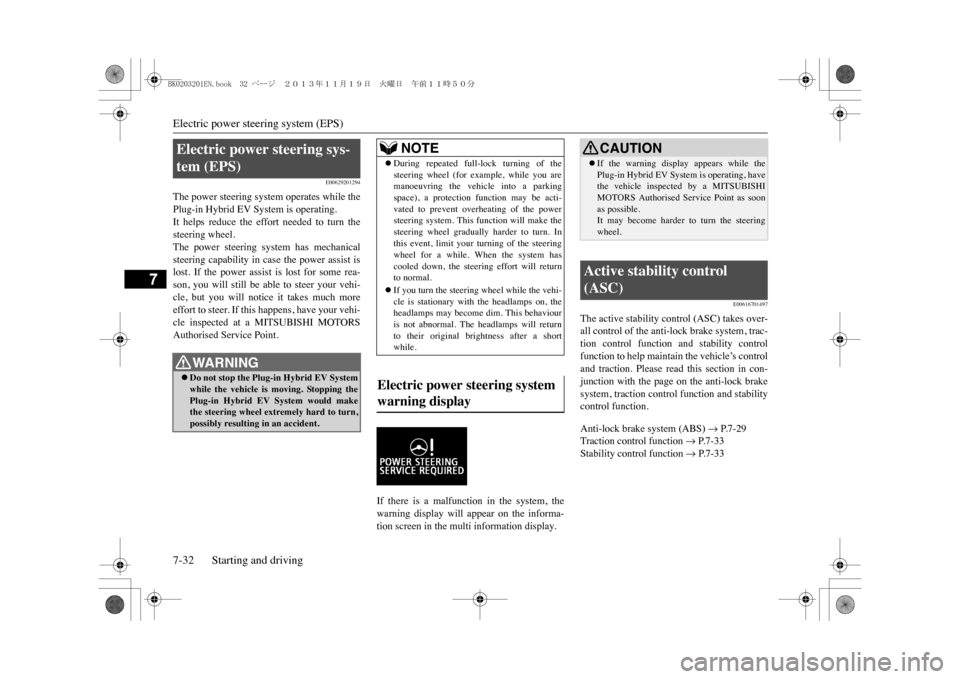
Electric power steering system (EPS)7-32 Starting and driving
7
E00629201294
The power steering system operates while thePlug-in Hybrid EV System is operating.It helps reduce the effort needed to turn thesteering wheel.The power steering system has mechanicalsteering capability in case the power assist islost. If the power assist
is lost for some rea-
son, you will still be able to steer your vehi-cle, but you will notice it takes much moreeffort to steer. If this happens, have your vehi-cle inspected at a MITSUBISHI MOTORSAuthorised Service Point.
If there is a malfunction in the system, thewarning display will appear on the informa-tion screen in the multi information display.
E00616701497
The active stability control (ASC) takes over-all control of the anti-lock brake system, trac-tion control function and stability controlfunction to help maintain the vehicle’s controland traction. Please read this section in con-junction with the page on the anti-lock brakesystem, traction control function and stabilitycontrol function.Anti-lock brake system (ABS)
�m P.7-29
Traction control function
�m P.7-33
Stability control function
�m P.7-33
Electric power steering sys-tem (EPS)
WA R N I N G�zDo not stop the Plug-in Hybrid EV Systemwhile the vehicle is moving. Stopping thePlug-in Hybrid EV System would makethe steering wheel extremely hard to turn,possibly resulting in an accident.
NOTE
�zDuring repeated full-lock turning of thesteering wheel (for example, while you aremanoeuvring the vehicle into a parkingspace), a protection function may be acti-vated to prevent overheating of the powersteering system. This function will make thesteering wheel gradually harder to turn. Inthis event, limit your turning of the steeringwheel for a while. When the system hascooled down, the steering effort will returnto normal.�zIf you turn the steering wheel while the vehi-cle is stationary with the headlamps on, theheadlamps may become dim. This behaviouris not abnormal. The headlamps will returnto their original brightness after a shortwhile.
Electric power steering system warning display
CAUTION�zIf the warning display appears while thePlug-in Hybrid EV System is operating, havethe vehicle inspected by a MITSUBISHIMOTORS Authorised Service Point as soonas possible.It may become harder to turn the steeringwheel.
Active stability control (ASC)
BK0203201EN.book 32 ページ 2013年11月19日 火曜日 午前11時50分
Page 196 of 388
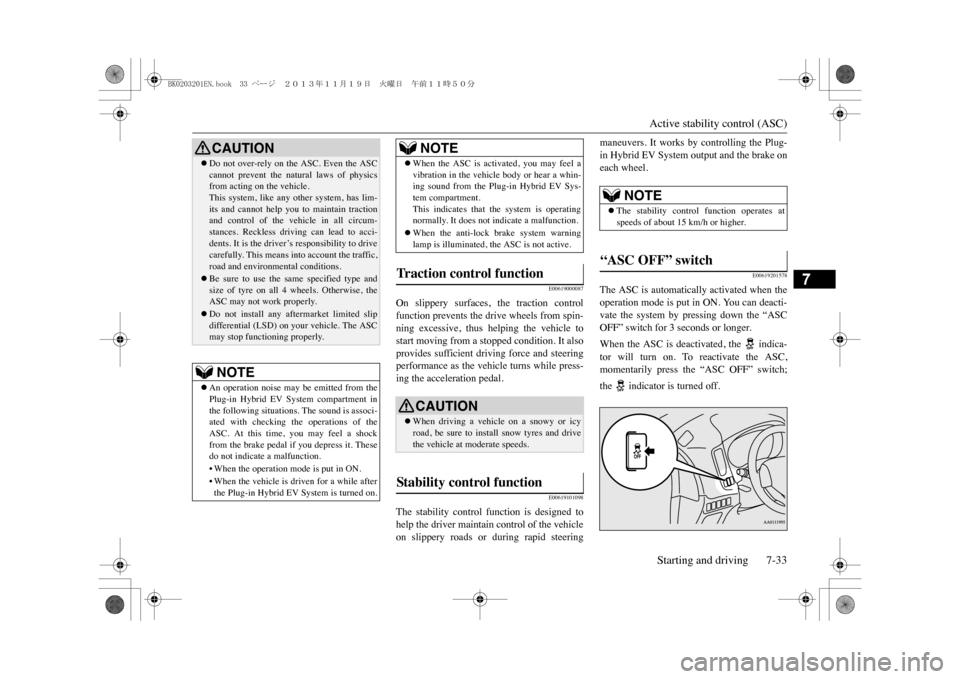
Active stability control (ASC)Starting and driving 7-33
7
E00619000087
On slippery surfaces, the traction controlfunction prevents the drive wheels from spin-ning excessive, thus helping the vehicle tostart moving from a stopped condition. It alsoprovides sufficient driving force and steeringperformance as the vehicle turns while press-ing the acceleration pedal.
E00619101098
The stability control function is designed tohelp the driver maintain control of the vehicleon slippery roads or during rapid steering
maneuvers. It works by controlling the Plug-in Hybrid EV System output and the brake oneach wheel.
E00619201578
The ASC is automatically activated when theoperation mode is put in ON. You can deacti-vate the system by pressing down the “ASCOFF” switch for 3 seconds or longer.When the ASC is deactivated, the indica-tor will turn on. To reactivate the ASC,momentarily press the “ASC OFF” switch;the indicator is turned off.
CAUTION�zDo not over-rely on the ASC. Even the ASCcannot prevent the natural laws of physicsfrom acting on the vehicle.This system, like any
other system, has lim-
its and cannot help you to maintain tractionand control of the vehicle in all circum-stances. Reckless drivi
ng can lead to acci-
dents. It is the driver’s
responsibility to drive
carefully. This means into account the traffic,road and environmental conditions.�zBe sure to use the same specified type andsize of tyre on all 4 wheels. Otherwise, theASC may not work properly.�zDo not install any aftermarket limited slipdifferential (LSD) on your vehicle. The ASCmay stop functioning properly.NOTE
�zAn operation noise may be emitted from thePlug-in Hybrid EV System compartment inthe following situations
. The sound is associ-
ated with checking the operations of theASC. At this time, you may feel a shockfrom the brake pedal if you depress it. Thesedo not indicate a malfunction.•When the operation mode is put in ON.•When the vehicle is driven for a while afterthe Plug-in Hybrid EV System is turned on.
�zWhen the ASC is activated, you may feel avibration in the vehicle body or hear a whin-ing sound from the Plug-in Hybrid EV Sys-tem compartment.This indicates that the system is operatingnormally. It does not indicate a malfunction.�zWhen the anti-lock brake system warninglamp is illuminated, the ASC is not active.
Tr a c t i o n c o n t r o l f u n c t i o n
CAUTION�zWhen driving a vehicle on a snowy or icyroad, be sure to install snow tyres and drivethe vehicle at moderate speeds.
Stability cont rol func tion
NOTE
NOTE
�zThe stability control function operates atspeeds of about 15 km/h or higher.
“ASC OFF” switch
BK0203201EN.book 33 ページ 2013年11月19日 火曜日 午前11時50分
Page 197 of 388
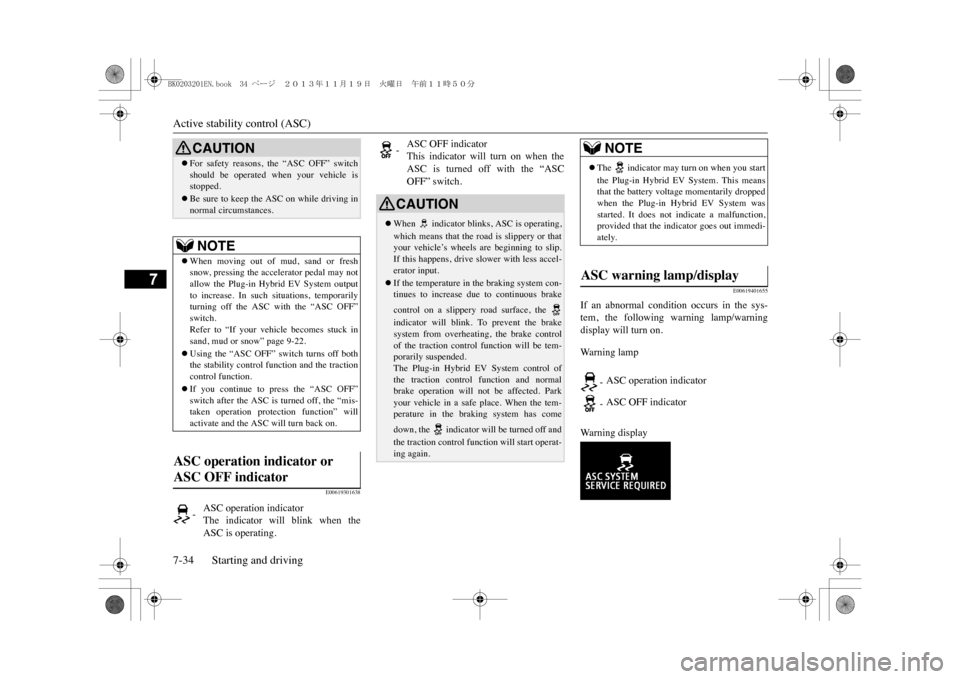
Active stability control (ASC)7-34 Starting and driving
7
E00619301638
E00619401655
If an abnormal condition occurs in the sys-tem, the following warning lamp/warningdisplay will turn on.Wa r n i n g l a m pWa r n i n g d i s p l a y
CAUTION�zFor safety reasons, th
e “ASC OFF” switch
should be operated when your vehicle isstopped.�zBe sure to keep the ASC on while driving innormal circumstances.NOTE
�zWhen moving out of mud, sand or freshsnow, pressing the accelerator pedal may notallow the Plug-in Hybrid EV System outputto increase. In such situations, temporarilyturning off the ASC with the “ASC OFF”switch.Refer to “If your vehicle becomes stuck insand, mud or snow” page 9-22.�zUsing the “ASC OFF” switch turns off boththe stability control function and the tractioncontrol function.�zIf you continue to press the “ASC OFF”switch after the ASC is turned off, the “mis-taken operation protec
tion function” will
activate and the ASC will turn back on.
ASC operation indicator or ASC OFF indicator
-ASC operation indicatorThe indicator will blink when theASC is operating.
-ASC OFF indicatorThis indicator will turn on when theASC is turned off with the “ASCOFF” switch.CAUTION�zWhen indicator bli
nks, ASC is operating,
which means that the road is slippery or thatyour vehicle’s wheels are beginning to slip.If this happens, drive slower with less accel-erator input.�zIf the temperature in the braking system con-tinues to increase due
to continuous brake
control on a slippery road surface, the indicator will blink. To prevent the brakesystem from overheating, the brake controlof the traction control function will be tem-porarily suspended.The Plug-in Hybrid EV
System control of
the traction control function and normalbrake operation will not be affected. Parkyour vehicle in a safe place. When the tem-perature in the braking system has comedown, the indicator w
ill be turned off and
the traction control function will start operat-ing again.
NOTE
�zThe indicator may turn on when you startthe Plug-in Hybrid EV System. This meansthat the battery voltage momentarily droppedwhen the Plug-in Hybrid EV System wasstarted. It does not indicate a malfunction,provided that the indicator goes out immedi-ately.
ASC warning lamp/display
-ASC operation indicator-ASC OFF indicator
BK0203201EN.book 34 ページ 2013年11月19日 火曜日 午前11時50分
Page 198 of 388
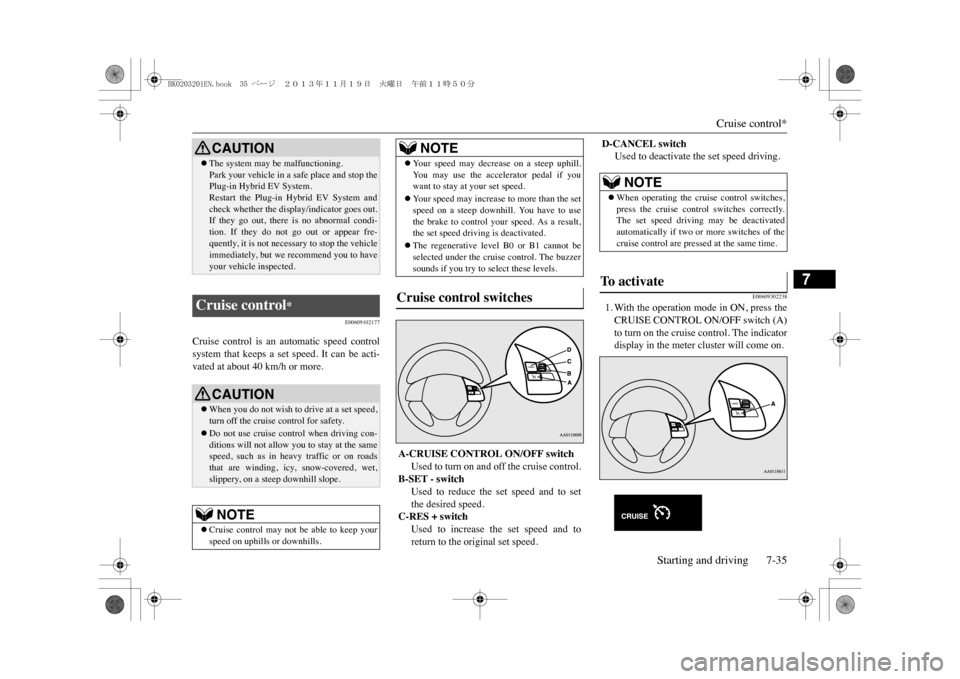
Cruise control*
Starting and driving 7-35
7
E00609102177
Cruise control is an automatic speed controlsystem that keeps a set speed. It can be acti-vated at about 40 km/h or more.
E00609302238
1. With the operation mode in ON, press theCRUISE CONTROL ON/OFF switch (A)to turn on the cruise control. The indicatordisplay in the meter cluster will come on.
CAUTION�zThe system may be malfunctioning.Park your vehicle in a safe place and stop thePlug-in Hybrid EV System.Restart the Plug-in Hybrid EV System andcheck whether the display/indicator goes out.If they go out, there is no abnormal condi-tion. If they do not go
out or appear fre-
quently, it is not necessary to stop the vehicleimmediately, but we recommend you to haveyour vehicle inspected.
Cruise control
*
CAUTION�zWhen you do not wish to drive at a set speed,turn off the cruise control for safety.�zDo not use cruise control when driving con-ditions will not allow you to stay at the samespeed, such as in heavy traffic or on roadsthat are winding, icy, snow-covered, wet,slippery, on a steep downhill slope.NOTE
�zCruise control may not be able to keep yourspeed on uphills or downhills.
�zYo u r s p e e d m a y d e c r e a s e o n a s t e e p u p h i l l .Yo u m a y u s e t h e a c c e l e r a t o r p e d a l i f y o uwant to stay at your set speed.�zYo u r s p e e d m a y i n c r e a s e t o m o r e t h a n t h e s e tspeed on a steep downhill. You have to usethe brake to control your speed. As a result,the set speed driving is deactivated.�zThe regenerative level B0 or B1 cannot beselected under the cruise control. The buzzersounds if you try to
select these levels.
Cruise control switches
A-CRUISE CONTROL ON/OFF switch
Used to turn on and off the cruise control.
B-SET - switch
Used to reduce the set speed and to setthe desired speed.
C-RES + switch
Used to increase the set speed and toreturn to the original set speed.NOTE
D-CANCEL switch
Used to deactivate the set speed driving.NOTE
�zWhen operating the cruise control switches,press the cruise control switches correctly.The set speed driving may be deactivatedautomatically if two or more switches of thecruise control are pressed at the same time.
To a c t i v a t e
BK0203201EN.book 35 ページ 2013年11月19日 火曜日 午前11時50分
Page 199 of 388
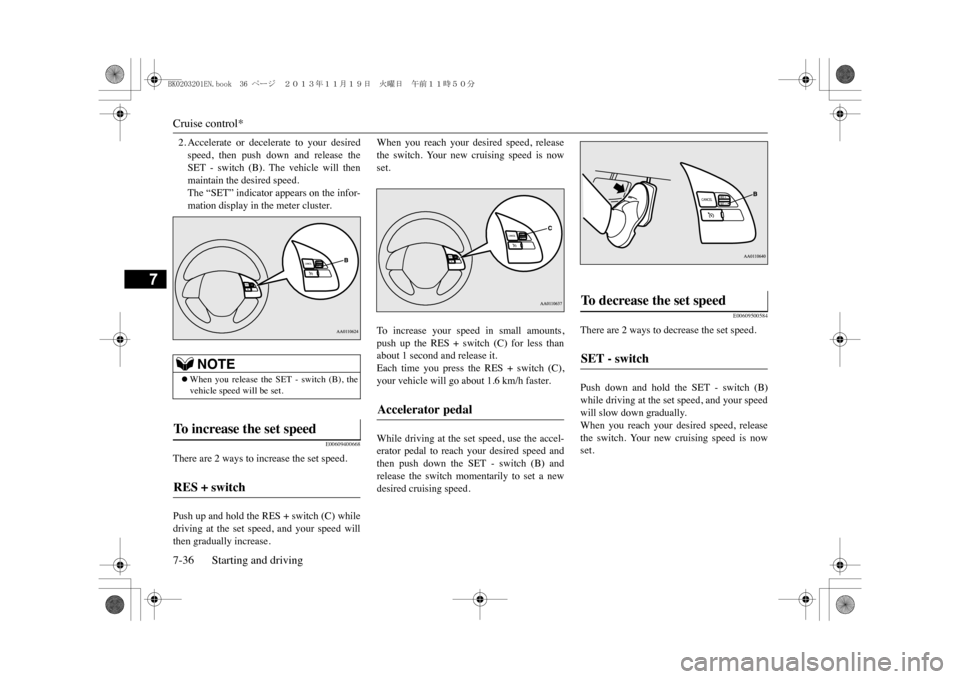
Cruise control*7-36 Starting and driving
7
2. Accelerate or decelerate to your desiredspeed, then push down and release theSET - switch (B). The vehicle will thenmaintain the desired speed.The “SET” indicator appears on the infor-mation display in the meter cluster.
E00609400668
There are 2 ways to increase the set speed.Push up and hold the RES + switch (C) whiledriving at the set speed, and your speed willthen gradually increase.
When you reach your desired speed, releasethe switch. Your new cruising speed is nowset.To increase your speed in small amounts,push up the RES + switch (C) for less thanabout 1 second and release it.Each time you press the RES + switch (C),your vehicle will go about 1.6 km/h faster.While driving at the set speed, use the accel-erator pedal to reach your desired speed andthen push down the SET - switch (B) andrelease the switch momentarily to set a newdesired cruising speed.
E00609500584
There are 2 ways to decrease the set speed.Push down and hold the SET - switch (B)while driving at the set speed, and your speedwill slow down gradually.When you reach your desired speed, releasethe switch. Your new cruising speed is nowset.
NOTE
�zWhen you release the SET - switch (B), thevehicle speed will be set.
To i n c r e a s e t h e s e t s p e e d
RES + switch
Accelerator pedal
To d e c r e a s e t h e s e t s p e e d
SET - switch
BK0203201EN.book 36 ページ 2013年11月19日 火曜日 午前11時50分
Page 200 of 388

Cruise control*
Starting and driving 7-37
7
To s l o w d o w n y o u r s p e e d i n s m a l l a m o u n t s ,push down the SET - switch (B) for less thanabout 1 second and release it.Each time you push down the SET - switch(B), your vehicle will slow down by about 1.6km/h.While driving at the set speed, use the brakepedal, which disengages the cruise control,then push down the SET - switch (B) andrelease the switch momentarily to set a newdesired cruising speed.
E00609601234
Depress the accelerator pedal as you wouldnormally. When you release the pedal, youwill return to your set speed.
Depress the brake pedal to decrease thespeed. To return to the previously set speed,push up the RES + switch (C).Refer to “To resume the set speed” on page7-38.
Brake pedal
To t e m p o r a r i l y i n c r e a s e o r decrease the speed
To t e m p o r a r i l y i n c r e a s e t h e s p e e d
NOTE
�zIn some driving conditions, the set speeddriving may be deactivated. If this happens,refer to “To activate” on page 7-35 andrepeat the speed setting procedure.
To t e m p o r a r i l y d e c r e a s e t h e s p e e d
BK0203201EN.book 37 ページ 2013年11月19日 火曜日 午前11時50分